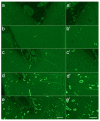Impact of sex and APOE4 on cerebral amyloid angiopathy in Alzheimer's disease
- PMID: 27179972
- PMCID: PMC4947445
- DOI: 10.1007/s00401-016-1580-y
Impact of sex and APOE4 on cerebral amyloid angiopathy in Alzheimer's disease
Abstract
Cerebral amyloid angiopathy (CAA) often coexists with Alzheimer's disease (AD). APOE4 is a strong genetic risk factor for both AD and CAA. Sex-dependent differences have been shown in AD as well as in cerebrovascular diseases. Therefore, we examined the effects of APOE4, sex, and pathological components on CAA in AD subjects. A total of 428 autopsied brain samples from pathologically confirmed AD cases were analyzed. CAA severity was histologically scored in inferior parietal, middle frontal, motor, superior temporal and visual cortexes. In addition, subgroups with severe CAA (n = 60) or without CAA (n = 39) were subjected to biochemical analysis of amyloid-β (Aβ) and apolipoprotein E (apoE) by ELISA in the temporal cortex. After adjusting for age, Braak neurofibrillary tangle stage and Thal amyloid phase, we found that overall CAA scores were higher in males than females. Furthermore, carrying one or more APOE4 alleles was associated with higher overall CAA scores. Biochemical analysis revealed that the levels of detergent-soluble and detergent-insoluble Aβ40, and insoluble apoE were significantly elevated in individuals with severe CAA or APOE4. The ratio of Aβ40/Aβ42 in insoluble fractions was also increased in the presence of CAA or APOE4, although it was negatively associated with male sex. Levels of insoluble Aβ40 were positively associated with those of insoluble apoE, which were strongly influenced by CAA status. Pertaining to insoluble Aβ42, the levels of apoE correlated regardless of CAA status. Our results indicate that sex and APOE genotypes differentially influence the presence and severity of CAA in AD, likely by affecting interaction and aggregation of Aβ40 and apoE.
Keywords: APOE; Alzheimer’s disease; Amyloid-β; Cerebral amyloid angiopathy; Sex.
Figures





Similar articles
-
Association between severe cerebral amyloid angiopathy and cerebrovascular lesions in Alzheimer disease is not a spurious one attributable to apolipoprotein E4.Arch Neurol. 2000 Jun;57(6):869-74. doi: 10.1001/archneur.57.6.869. Arch Neurol. 2000. PMID: 10867785 Clinical Trial.
-
Murine versus human apolipoprotein E4: differential facilitation of and co-localization in cerebral amyloid angiopathy and amyloid plaques in APP transgenic mouse models.Acta Neuropathol Commun. 2015 Nov 10;3:70. doi: 10.1186/s40478-015-0250-y. Acta Neuropathol Commun. 2015. PMID: 26556230 Free PMC article.
-
APOE epsilon 4 influences the pathological phenotype of Alzheimer's disease by favouring cerebrovascular over parenchymal accumulation of A beta protein.Neuropathol Appl Neurobiol. 2003 Jun;29(3):231-8. doi: 10.1046/j.1365-2990.2003.00457.x. Neuropathol Appl Neurobiol. 2003. PMID: 12787320
-
Cerebral amyloid angiopathy and its relationship to Alzheimer's disease.Acta Neuropathol. 2008 Jun;115(6):599-609. doi: 10.1007/s00401-008-0366-2. Epub 2008 Mar 28. Acta Neuropathol. 2008. PMID: 18369648 Review.
-
Relationship between severe amyloid angiopathy, apolipoprotein E genotype, and vascular lesions in Alzheimer's disease.Ann N Y Acad Sci. 2000 Apr;903:138-43. doi: 10.1111/j.1749-6632.2000.tb06360.x. Ann N Y Acad Sci. 2000. PMID: 10818499 Review.
Cited by
-
Tau and apolipoprotein E modulate cerebrovascular tight junction integrity independent of cerebral amyloid angiopathy in Alzheimer's disease.Alzheimers Dement. 2020 Oct;16(10):1372-1383. doi: 10.1002/alz.12104. Epub 2020 Aug 22. Alzheimers Dement. 2020. PMID: 32827351 Free PMC article.
-
Claudin-5 relieves cognitive decline in Alzheimer's disease mice through suppression of inhibitory GABAergic neurotransmission.Aging (Albany NY). 2022 Apr 26;14(8):3554-3568. doi: 10.18632/aging.204029. Epub 2022 Apr 26. Aging (Albany NY). 2022. PMID: 35471411 Free PMC article.
-
Tau depletion diminishes vascular amyloid-related deficits in a mouse model of cerebral amyloid angiopathy.Alzheimers Dement. 2025 May;21(5):e70238. doi: 10.1002/alz.70238. Alzheimers Dement. 2025. PMID: 40346706 Free PMC article.
-
Apolipoprotein E in lipid metabolism and neurodegenerative disease.Trends Endocrinol Metab. 2023 Aug;34(8):430-445. doi: 10.1016/j.tem.2023.05.002. Epub 2023 Jun 24. Trends Endocrinol Metab. 2023. PMID: 37357100 Free PMC article. Review.
-
Leading mediators of sex differences in the incidence of dementia in community-dwelling adults in the UK Biobank: a retrospective cohort study.Alzheimers Res Ther. 2023 Jan 9;15(1):7. doi: 10.1186/s13195-022-01140-2. Alzheimers Res Ther. 2023. PMID: 36617573 Free PMC article.
References
-
- Alzheimer'sAssociation 2015 Alzheimer’s Disease Facts and Figures. Alzheimer’s & Dementia. 2015;11:332–384. - PubMed
-
- Bakker EN, Bacskai BJ, Arbel-Ornath M, Aldea R, Bedussi B, Morris AW, Weller RO, Carare RO. Lymphatic Clearance of the Brain: Perivascular, Paravascular and Significance for Neurodegenerative Diseases. Cell Mol Neurobiol. 2016 doi: 10.1007/s10571-015-0273-8. 10.1007/s10571-015-0273-8 [pii] - DOI - PMC - PubMed
Publication types
MeSH terms
Substances
Grants and funding
LinkOut - more resources
Full Text Sources
Other Literature Sources
Medical
Miscellaneous

